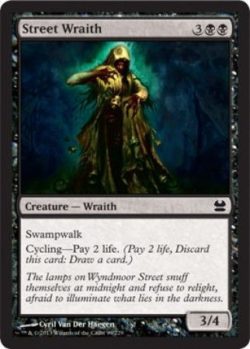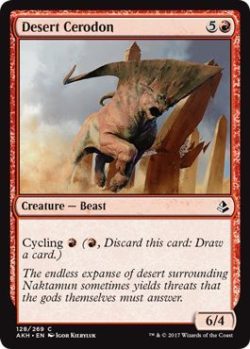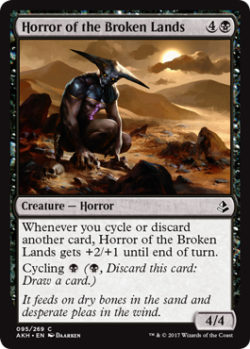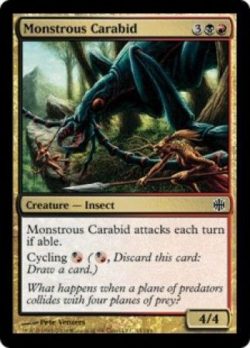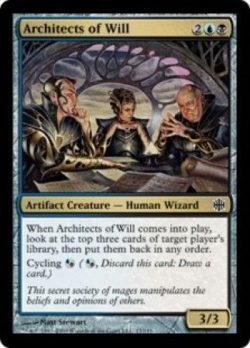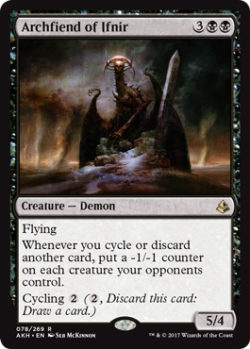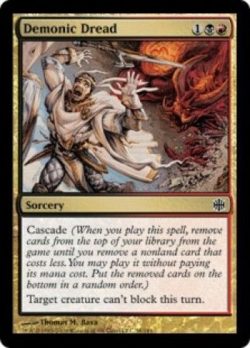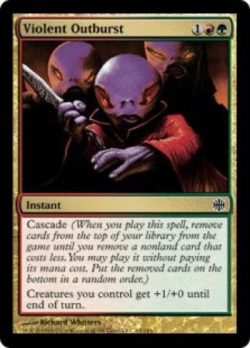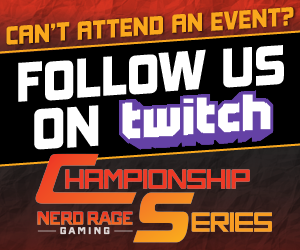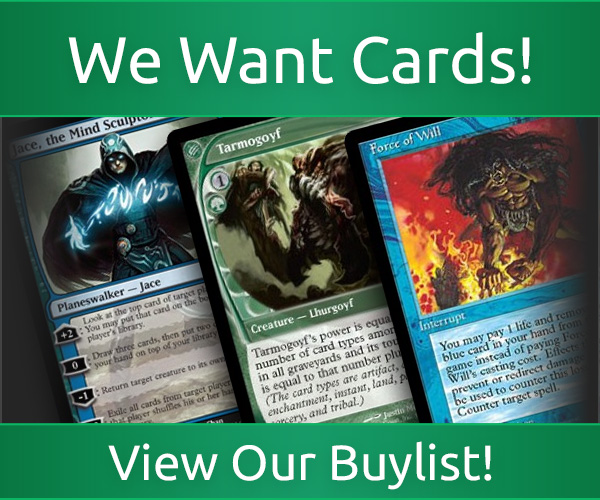The State of Modern: Living End, by Justin Brickman
The thing about Modern is that unless bannings are involved, decks usually don’t die, even if they fall off the radar for a while.
Instead, they quietly wait for their time to shine. For Living End, that time has come.
As Modern’s card pool continues to grow, it is becoming more common that new cards find their way into decks very quickly. Due to the nature of Living End, it is often difficult to find slots for new cards outside of a few sideboard tweaks. That changed when Amonkhet was released and the cycling mechanic was revived. Now equipped with several new tools, Living End is primed for a comeback.
The Deck
Living End, by Justin Brickman
Living End is a creature-based combo deck that utilizes the cycling mechanic to put some pretty good-looking draft commons into the graveyard, then uses either Violent Outburst or Demonic Dread to cast Living End. This not only puts all these creatures into play, but clears your opponent’s board as well. The appeal to this deck is that the deck is almost all self-fueling engine, as cycling creatures will find more creatures to cycle or your Cascade spells to fire off a Living End.
The Untouchables
Rule No. 1: You cannot have any cards in the deck that cost less than three mana. The deck works because you hit Living End 100 percent of the time when you cast a Cascade spell. Given that, there are strict restrictions that we are forced to follow. Most of the deck is locked in as the cheapest options available in Modern. These slots are 22 cyclers (four “free”; 15 one-mana; three two-mana), eight Cascade spells, and three Living Ends.
Creatures
4 Street Wraith
4 Desert Cerodon
4 Horror of the Broken Lands
4 Monstrous Carabid
3 Architects of Will
3 Archfiend of Ifnir
These cards are locked in, as they are the most efficient cyclers available. The correct number of cyclers is somewhere between 20 and 24; this lets you either have some more flex spots or be nearly all engine. It is also important that our cyclers can be cast, as Plan B against graveyard hate is just casting your creatures. The exception to this is Architects of Will. However, the ability to manipulate the top three cards of your opponent’s library is insanely powerful in Modern. Depending on the size of the Living End and their board position at that point, it’s likely you’ll know every card they’ll see for the rest of the game.
With the release of Amonkhet, Living End gained a huge boost in power level, as it got to upgrade some of the more underpowered cyclers for larger bodies and some pretty sweet abilities. Prior to Amonkhet, Living End played Deadshot Minotaur, Jungle Weaver, and Twisted Abomination. The higher density of two-mana cyclers made it take longer to set up a lethal Living End. Those creatures are also less powerful than the new additions, meaning previous versions took an extra two turns to deal lethal damage.
Horror of the Broken Lands is a huge addition to the deck, as it just hits in huge chunks. Archfiend of Ifnir is already fantastic as a five-power flier, but being able to clean up your opponent’s board is a huge plus. There are several matchups where they have to kill this before you start cycling or they lose on the spot. Desert Cerodon is very plain, but a 6/4 is a very strong body for Modern, as it is able to outclass or trade with almost everything on the ground except for the occasional very large Death’s Shadow.
Street Wraith is one of the best enablers in the deck because it’s free to cycle. The manabase is built in a way that we aren’t dealing ourselves a ton of damage, so we aren’t too worried about paying the life, as we’re usually winning the race in most cases. Having a free cycler is huge for the deck because it pushes the “go off” turn to as soon as turn two.
Enablers
4 Violent Outburst
4 Demonic Dread
These are simply the cheapest Cascade spells available in Modern.
Win Conditions
3 Living End

Casting this card is what the deck is all about. The philosophy behind three copies over four is that you should never need the third copy, but you want to have as many as you can in your deck while keeping the chances of drawing them down.
The Flex Spots
Twenty-two cyclers, eight cascade spells, three Living Ends and 22 mana sources brings us to 55 cards, leaving us with five flex slots. These slots are typically filled up by some disruptive packages that also give us targets for Demonic Dread in the case that our opponent refuses to cooperate and we can’t find a Violent Outburst. In this list, I have three Beast Within and two Faerie Macabre.
Beast Within is almost always in the 75 somewhere. Until recently it had been in the sideboard, but once you feel like a card is coming in against almost every matchup, you should probably just main deck it. This is an instant-speed Vindicate with the upside of turning on Demonic Dread. Having a main deck catch-all is a powerful thing in combo decks, because you never know what kind of hate is floating around people’s main decks. The biggest offender as far as Living End is concerned would be Eldrazi Tron, with main deck Relic of Progenitus and Chalice of the Void.
Faerie Macabre is another former sideboard card that I’ve put on the back burner in favor of Leyline of the Void, but with the dominance of Death’s Shadow I’ve elected to try both in the 75. Having Faerie Macabre helps break serve in the weird game of chicken that evolves when the Shadow player cycles their own Street Wraith and mills over creatures via Thought Scour. Some awkward situations come up with Living End being a symmetrical effect, and Faerie Macabre is similar to Archfiend of Ifnir in the way that it helps break the symmetry.
If your meta has a ton of Tron, Titan Shift or other big mana strategies, Fulminator Mage is another common card that occupies both flex slots. Fulminator is usually 2-3 Stone Rains per game, which leans games against G/x Tron heavily in your favor. However, with the rise of Eldrazi Tron, Fulminator has become less effective in constraining their mana as they are able to operate without Tron.
The Mana
The best part about having a deck where step one of your game plan is drawing a bunch of cards is that you get to play a low land count, especially for a deck that has a pretty high curve for Modern. Another thing that lets you get away with so few lands is four copies of Simian Spirit Guide. I’ve been pretty vocal about Lotus Petal not being a thing in Modern, but if Wizards wants to leave it in the format I’ll just play one of the best decks to exploit it. It’s also noteworthy that sometimes you just need to cast a mana monkey to have a Demonic Dread target.
As for actual lands, 18 is a pretty standard number. One of the highlights is that because the deck functions on so few lands, we get to utilize the Scars of Mirrodin and Kaladesh fast lands to have a fairly pain-free mana base. There are still four Verdant Catacombs and one of each Jund-colored shock land to have some control over color fixing.
One of the more recent additions to the mana base is three copies of Grove of the Burnwillows as a land that always enters untapped and a slight hedge to keep Death’s Shadow from getting too big. In this matchup, tap it for colored mana every time, even if it’s completely irrelevant, because the extra point of life to them will be a bigger setback than it will be for you. You’re going to be hitting in larger chunks.
The Sideboard
Part of the cost of having a deck that revolves around cascading into a specific card is that your sideboard options get limited very quickly. However, I’m confident in the power level of this sideboard, as it gives you all the tools you need to not only disrupt your opponent’s game plan, but also force through your own.
Usually with combo decks it’s important to not over-board. That isn’t an issue with Living End, as you’re either trying to be aggressive in forcing through a Living End or trying to play the disruptive game and making it significantly harder for your opponent to win.
The worst matchups for Living End are spell-based combo decks such as Ad Nauseam and Gifts Storm. It’s also hard to interact with Titan Shift without Beast Within. This comes in against basically any deck that is relying on a single card or “A+B” combo to win. Being able to cut them out of their main way to win will either win the game on the spot, or force them to go through some hoops to win, giving you a ton of time to set up a lethal Living End. This can also be Slaughter Games.
These are great against every creature deck in Modern, specifically green midrange decks and Collected Company decks. The primary target is Scavenging Ooze, as it can be a minor annoyance, but is not unbeatable. Evoke is a huge mechanic for Living End, as it allows us to get these great spell effects at a normal rate, but also attached to a creature that will come back with Living End. This allows us to propel our game plan forward while not being set back due to the deck-building restrictions associated with the deck
Very similar in philosophy to Shriekmaw, Ingot Chewer is your best card against Affinity as getting a Ravager or Cranial Plating off the table helps make sure games can’t slip away after a Living End. There are a ton of artifacts that can be anywhere from mildly annoying to a big problem. Relic of Progenitus and Nihil Spellbomb are incredibly beatable, but Chalice of the Void is a huge problem, and it’s crucial to have enough answers to whatever artifact our opponents might throw our way.
This is exclusively for Burn. It is not a great matchup, as their creatures will get the early points of damage in and then they can lean on spells for the rest of the game. Another option for this slot can be Gnaw to the Bone, but cycling Street Wraith and Gnaw to the Bone are life neutral. Gnaw also doesn’t play well into Skullcrack. Brindle Boar gives you more flexibility, as well as getting a free block in and being able to force the action on Skullcrack, then get the boar back with Living End.
3 Leyline of the Void
This is the graveyard hate of choice in addition to the two Faerie Macabres in the main deck. Relic, Spellbomb, and Rest in Peace are not options, because we don’t want anything we could cascade into. With Leyline we get to have the opening hand upside, but it is still castable and can be powered out early by Simian Spirit Guide. Because the deck sees so many cards, I opted to go with only three copies rather than four. We want it in our opener, but not in subsequent draws. Having only three copies means we have to mulligan slightly more aggressively for them, but not having a fourth copy helps the overall flow of the deck in the long run. More Faerie Macabres can be included over these since they work well with the overall flow of the deck, but I feel the best path to victory against Dredge is just turning off their graveyard completely.
Dredge and Death’s Shadow are both super back and forth matchups, and their graveyards are their greatest resource. The difference between how these decks function with their graveyard versus without it is huge, and Leyline is good enough to win the game on its own.
Ricochet Trap is your anti-blue protection. You only get so many tries with Living End, so you need to make each attempt count against decks with counter magic. This is especially true against Death’s Shadow where you are under a quick clock.
Other sideboard options are:
–Blood Moon if you anticipate a lot of Tron decks.
–Anger of the Gods as another card to keep Dredge and Collected Company decks in check.
–Leyline of Sanctity if you expect a lot of burn and combo.
Good Matchups
When you take Living End into battle you’re hoping to run into decks that are relying on attacking with creatures to win. The bread and butter matchups are B/G/x midrange decks, as they simply can’t effectively contain what we are trying to do. Discard and Liliana are at their worst in this matchup, as you get to see so many cards and there is so much redundancy in the deck. They also don’t present a clock that is unmanageable. Other specific matchups that you’d pray to the pairings gods for are most Collected Company decks, Elves and Merfolk. These decks have very little in terms of disruption and are all about trying to beat down so just surviving to the first Living End is usually enough to win the race.
A good many matchups are cases of “Can I do what I’m trying to do before you do what you want to do?” This category includes Dredge, Affinity and Counters Company. These cases are where Archfiend of Ifnir flexes its muscle, as these decks are so good at rebuilding their board after a Living End. Archfiend comes down and breaks serve by clearing out all the nonsense from Bloodghast, Narcomoeba, Arcbound Ravager, Viscera Seer and Kitchen Finks.
Death’s Shadow is a very interesting matchup to try to dissect, as there are a bunch of weird sub-games that go on. The fact that they can use Street Wraith and Thought Scour to get creatures in their yard to make Living End worse creates a weird situation where we try to leverage Beast Within and Faerie Macabre. Game 1 is slightly favorable, as they have fair number of blanks in Fatal Push and discard spells, but the sideboard gives more effective ways to fight their disruption. I would call the matchup slightly favorable to 50/50.
Bad Matchups
As I’ve stated earlier, most matchups tend to be pretty even. However, most other combo decks can create issues. Spell-based combo decks such as Ad Nauseam and Storm are the worst matchups, simply because of how difficult it is to interact with their actual combo kills.
There are some ways to interact with their set-up plans, such as blowing up Ad Nauseam’s artifact mana with Ingot Chewer or preemptively hitting a Phyrexian Unlife with Beast Within. With Storm it’s possible that they Empty the Warrens and you can clean up the board with Living End, but the skilled Storm players will just sit back and build up the perfect hand and force you to act first.
Titan Shift is a unfavorable but very winnable matchup. The hardest part is that they are careful about exposing Valakut to a Fulminator Mage. Sakura-Tribe Elder plays very well against Living End, as it can ramp them twice, making it likely that you will die on the first Primeval Titan.
Living End also has a difficult time against control decks and other decks that are packing a fair amount of counterspells. However these games tend to go long, so hard casting creatures and using a suspended Living End as inevitability comes up quite a bit. The difficulty is that Path to Exile makes its way into the equation, and outside of casting Living End we are stuck in one spell per turn territory for most of the game, making it difficult to out-tempo them.
Gameplay
One of the toughest parts of playing Living End is your deck is a bunch of cyclers and you don’t really know what they will turn into. The ideal opening hand involves two lands (black/red is the most important to have access to as it lets you cycle everything), 3-4 cyclers and 1-2 cascade spells.
Sometimes you’re going to get functional hands that also contain a Living End; they aren’t necessary mulligans. However any hand with two or more Living Ends is an auto-mull. Thankfully, as a “38-card deck,” it mulligans very well. Prior to Amonkhet, the goal was to get a huge board after a Living End resolved, and this could take several turns as there were more two-mana cyclers. Now it’s possible to make a quicker, smaller Living End that is just as effective. The triggered ability of Horror of the Broken Lands allows you to force them to answer the first wave of creatures, as it still is presenting a ton of damage while building up a backup just in case.
Street Wraith is a card that is usually better to try to hold if you have Archfiend, as presenting an extra three-power creature is nothing too impressive, but having a free way to trigger Archfiend is incredibly hard to overcome for some decks.
Architects of Will is an interesting card. It’s primarily targeting your opponent, allowing you to decide what they are drawing for the next three turns unless they have a shuffle effect. This can get kind of tricky as you need to have a good read on their hand. We don’t have discard to give us perfect information. When you have multiple Architects, it’s important to always have the first one target your opponent.
As for sequencing lands, it is usually pretty dependent on what cyclers you have access to. Ideally, Blackcleave Cliffs is the first land you play followed by Blooming Marsh. Due to the amount of fast lands, it’s often the case that if you need to fetch, you’ll either fetch Blood Crypt or a basic most of the time. But, again, all of that is dependent on the exact makeup of your hand.
Wrap Up
I’ve enjoyed playing this deck for years and am glad to finally have some new tools to work with. Living End is incredibly consistent and powerful, yet it has flown under the radar for so long due to the fact that it hasn’t received any new tools in several years while the format is quickly changing and growing faster and faster. Thanks to Amonkhet, I’m confident that Living End has the power level to take down any tournament.
Justin Brickman is an SCG Tour grinder from suburban Chicago who began playing Magic during Innistrad block. His Magic accomplishments include an SCG Regionals Top 16 and a Super Sunday Series Top 4. He can be reached on Twitter @BrickerclawMyr.


